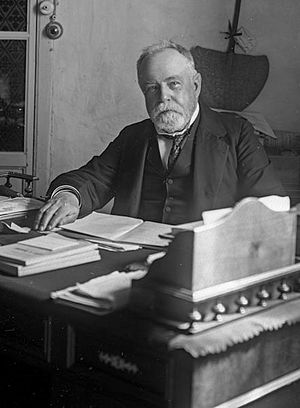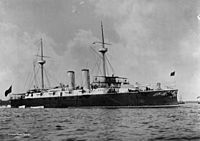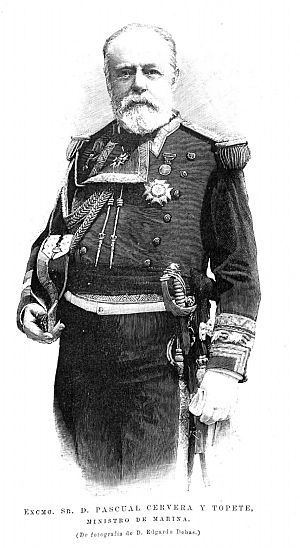Pascual Cervera y Topete facts for kids
Quick facts for kids
The Most Excellent
Pascual Cervera
|
|
|---|---|
 |
|
| Minister of the Navy | |
| In office 14 December 1892 – 23 March 1893 |
|
| Monarch | Alfonso XIII of Spain |
| Prime Minister | Práxedes Mateo Sagasta |
| Preceded by | José López Domínguez |
| Succeeded by | Manuel Pasquín de Juan |
| Personal details | |
| Born | February 18, 1839 Medina-Sidonia, Cádiz province, Spain |
| Died | April 3, 1909 (aged 70) Puerto Real, Cádiz province, Spain |
| Resting place | Panteón de Marinos Ilustres, San Fernando, Cádiz province, Spain |
| Military service | |
| Allegiance | |
| Branch/service | |
| Years of service | 1858–1907 |
| Rank | |
| Commands | Navy Staff Cuba Squadron Ministry of the Navy Cartagena harbor Battleship Pelayo Corvette Ferolana Corvette Santa Lucia Schooner Circe |
| Battles/wars | Ten Years' War Spanish–Moroccan War Spanish–Moro conflict
|
Admiral Pascual Cervera y Topete (born February 18, 1839, died April 3, 1909) was an important Spanish naval officer. He reached the high rank of Admiral in the Spanish Navy. He fought in several wars and held many important jobs during his career.
Cervera served in places like Morocco, the Philippines, and Cuba. He became Spain's naval minister and chief of naval staff. He was also a naval expert in London. Most famously, he led the Cuba Squadron during the Spanish–American War. Even though he knew the Spanish Navy had many problems and likely couldn't win against the United States Navy, Cervera bravely led his squadron. He fought in a final battle at Battle of Santiago de Cuba.
Contents
Pascual Cervera was born in Medina-Sidonia, a town in the Cádiz area of Spain. His father was an officer in the Spanish Army. When Pascual was thirteen, he joined the naval college. In 1858, he became a midshipman on his first trip to Havana, Cuba.
At 21, he became a lieutenant junior grade. He served in Cuba and Morocco, fighting in wars there. Later, he went to the Spanish Philippines. In 1864, he helped capture Fort Pagalungan from rebels. He was very brave and even captured the enemy flag. For this, he was promoted to lieutenant.
Afterwards, Cervera helped map the many islands of the Philippines. This work was very helpful for sailors. In 1865, he returned to Spain and got married.
Challenges and Commands
Spain had many political problems during Cervera's time. He helped put down a rebellion during one of the Carlist Wars. He later commanded ships in the Philippines again, fighting against rebels. In 1876, he became the Governor of Jolo. However, he got very sick with malaria there. He barely survived and returned to Spain.
The Prime Minister, Antonio Cánovas del Castillo, asked Cervera to become the Minister of the Navy. But Cervera said no. He preferred to be at sea, commanding ships, rather than working in an office.
In 1879, he took command of a training ship called Ferolana. He stayed there until 1882. Then, he was put in charge of the Cartagena naval base. From 1885 to 1890, he worked on building the battleship Pelayo. He became its first commander. He had to deal with many delays and problems from the navy's rules.
Serving in the Government
In 1891, the Queen Regent María Cristina asked Cervera to be her naval aide-de-camp. This meant he was a special assistant for naval matters. A year later, she asked him to oversee the building of new ships.
Many politicians wanted Cervera to be the Minister of the Navy. He kept saying no because he didn't like politics. Finally, in 1892, Prime Minister Práxedes Mateo Sagasta asked the Queen Regent to make him accept the job. She did, and Cervera reluctantly agreed. He was promoted to rear admiral.
Cervera made the prime minister promise not to cut the navy's budget. The prime minister agreed. But soon after, he broke his promise. So, Cervera resigned in 1892. Before leaving, he tried to make the Spanish Navy better and more efficient. After this, he became a naval expert in London. He saw new technologies being used by the British Royal Navy. He stayed there until the situation in Cuba became very tense around 1896–97.
The Spanish–American War
Admiral Cervera was worried about the growing tensions between Spain and the United States. He believed Spain would lose a war because the U.S. Navy was much stronger. He thought Spain didn't have enough ships to defend its colonies.
Even so, he accepted the job of commander of the Cuban squadron on October 20, 1897. He immediately started training his crews. The Spanish Navy hadn't done drills since 1884! Cervera tried to fix many problems, like lack of training and supplies. But he still faced difficulties from the naval ministry.
In February 1898, the American battleship USS Maine exploded in Havana harbor. Cervera quickly went back to Spain to talk to the government. But he received orders to take his ships to Cuba and prepare for war. This was despite the many problems his fleet had.
Cervera returned to the Caribbean. He managed to get past American ships and entered Santiago de Cuba harbor on May 19. This was difficult because many European countries were neutral and wouldn't let him refuel. His fleet included four cruisers: Infanta Maria Teresa (his main ship), Vizcaya, Almirante Oquendo, and Cristóbal Colón. He also had two destroyers.
The U.S. Navy didn't know where Cervera's squadron was for several days. Then, on May 28 or 29, the American Flying Squadron found them in Santiago harbor. On May 31, the two sides exchanged fire. Cervera's Cristóbal Colón fired at three American ships. Neither side was damaged, and Cervera ordered his ship back to the harbor.
The rest of the U.S. fleet arrived on June 1. They blockaded Cervera's squadron in Santiago. On June 2–3, the American commander tried to block the harbor entrance. He tried to sink a coal ship, the USS Merrimac, in the entrance. But the Spanish defenders fired at it, and it got stuck. Admiral Cervera personally met the American crewmen, who were taken prisoner.
He later sent a message to the American admiral. He told him the crew was alive and safe. This act of kindness impressed the American officers.
The Battle of Santiago de Cuba
Cervera's fleet stayed in the harbor for about a month. On July 2, the military governor of Cuba, Ramón Blanco, ordered the fleet to leave the harbor and fight. Admiral Cervera had argued against this, but Blanco insisted.
The Spanish fleet left the harbor on July 3. The U.S. fleet sounded the alarm at 9:31 in the morning. Cervera's flagship, Infanta Maria Teresa, led the way. The Spanish ships opened fire and fought the U.S. fleet. They tried to head west along the coast.
Cervera's flagship took heavy damage. Its engines were damaged. Cervera decided to run the Infanta Maria Teresa aground, which they did at 10:15 am. Around 10:20, the Almirante Oquendo was also badly damaged and grounded. The two destroyers, Plutón and Furor, fought hard. The Plutón ran aground, and the Furor was sunk by 10:30 am.
As Cervera's flagship raised a white flag, the remaining two cruisers, Vizcaya and Colón, were chased. The Vizcaya was destroyed around 11:00 am. The Colón made it fifty miles from Santiago before being grounded on a beach.
After the battle, American ships rescued the Spanish sailors. Admiral Cervera was among those captured from the Infanta Maria Teresa. That afternoon, he went aboard the USS Iowa. He and other Spanish officers formally surrendered.
Cervera and the other prisoners were sent to Annapolis, Maryland. They were allowed to move freely around the U.S. Naval Academy. Americans cheered them, impressed by their bravery. The New York Times reported that Cervera was "much affected" by the warm welcome.
On August 20, the U.S. government offered him freedom. The condition was that he would not fight against the United States again. But Cervera refused. He said accepting conditional freedom was against Spanish law. He did not return to Spain until September 1898. After the war, he became popular with both the Spanish and American public.
Later Life and Recognition
In February 1901, Cervera was promoted to vice admiral. In December 1902, he became the Chief of Staff of the Navy. This meant he was the head of the entire navy. In May 1903, King Alfonso XIII of Spain made him a senator for life. This meant he was a lifelong member of the government.
By 1906, his health was getting worse. Cervera was put in charge of the naval area of Ferrol. He retired the next year. He passed away on April 3, 1909.
Admiral Cervera remained a popular hero even after his death. The Spanish Navy honored him by naming a light cruiser after him. This showed he was a symbol of patriotism.
Personal Life
Admiral Cervera was married and had several children. He lived his private life with a strict routine. One of his sons also served in the Spanish Navy and was with his father at Santiago. Cervera also spoke English very well.
Awards
 Order of Isabella the Catholic
Order of Isabella the Catholic Royal and Military Order of Saint Hermenegild
Royal and Military Order of Saint Hermenegild Naval Merit Grand Cross
Naval Merit Grand Cross Naval Merit Cross with white badge
Naval Merit Cross with white badge Naval Merit Cross with red badge
Naval Merit Cross with red badge
Images for kids
See also
 In Spanish: Pascual Cervera y Topete para niños
In Spanish: Pascual Cervera y Topete para niños




